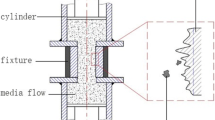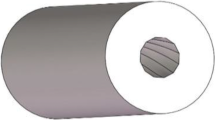Abstract
Traditional finishing technology is difficult to realize the precision machining of complex geometric parts. Abrasive flow machining technology solves this problem well. Taking the spur internal gear as the research object, the wall shear force, static pressure, dynamic pressure, and abrasive velocity vector of the internal channel of the straight internal gear under different inlet velocity, abrasive concentration, and abrasive particle size are analyzed by using the large eddy simulation method, and the action law of different parameters on the machining of straight internal gear by solid–liquid two-phase abrasive flow is discussed. At the same time, the orthogonal test was carried out. The results show that the solid–liquid two-phase abrasive flow machining technology can effectively remove the burrs, pits, and bulges on the tooth surface of spur internal gear, reduce the tooth surface roughness, and improve the surface quality. The optimal combination of processing parameters and the primary and secondary order of various factors affecting processing are obtained by range analysis and analysis of variance. The regression equation is constructed by regression analysis to verify the effectiveness and accuracy of the model, which provides theoretical support and data reference for actual processing and production.
Graphic abstract






















Similar content being viewed by others
References
Chen ZB, He L, Liao J (2021) Design and analysis of conjugated straight-Line internal gear pairs. Int J Precis Eng Manuf 22:1425–1440. https://doi.org/10.1007/s12541-021-00510-4
Liu XR, Wang ZH (2018) Research on high-precision form grinding technology of gear based on ambient temperature adaptability. Math Probl Eng 11:1–13. https://doi.org/10.1155/2018/4619624
Zhang SJ, To S, Wang SJ, Zhu ZW (2015) A review of surface roughness generation in ultra-precision machining. Int J Mach Tool Manuf 91:76–95. https://doi.org/10.1016/j.ijmachtools.2015.02.001
Fu YZ, Gao H, Yan QS, Wang XP, Wang X (2020) Rheological characterisation of abrasive media and finishing behaviours in abrasive flow machining. Int J Adv Manuf Tech 107:3569–3580. https://doi.org/10.1007/s00170-020-05288-9
Kumar SS, Hiremath SS (2016) A review on abrasive flow machining (AFM). Procedia Technol 25:1297–1304. https://doi.org/10.1016/j.protcy.2016.08.224
Cheema SM, Venkatesh G, Dvivedi A, Sharma AK (2012) Developments in abrasive flow machining: a review on experimental investigations using abrasive flow machining variants and media. Proc Inst Mech Eng B J Eng 226(12):1951–1962. https://doi.org/10.1177/0954405412462000
Fu YZ, Gao H, Yan QS, Wang XP, Wang X (2020) An efficient approach to improving the finishing properties of abrasive flow machining with the analyses of initial surface texture of workpiece. Int J Adv Manuf Tech 107:2417–2432. https://doi.org/10.1007/s00170-020-05173-5
Suzuki H, Oohashi K (2018) Special issue on precision abrasive technology of difficult-to-machine materials. Int J Auto Tech 12(6):861. https://doi.org/10.20965/ijat.2018.p0861
Dixit N, Sharma V, Kumar P (2021) Research trends in abrasive flow machining: a systematic review. J Manuf Process 64:1434–1461. https://doi.org/10.1016/j.jmapro.2021.03.009
Bremerstein T, Potthoff A, Michaelis A, Schmiedel C, Uhlmann E, Blug B, Amann T (2015) Wear of abrasive media and its effect on abrasive flow machining results. Wear 342–343:44–51. https://doi.org/10.1016/j.wear.2015.08.013
Fang MH, Yu T, Xi FF (2020) An experimental investigation of abrasive suspension flow machining of injector nozzle based on orthogonal test design. Int J Adv Manuf Tech 110:1071–1082. https://doi.org/10.1007/s00170-020-05914-6
Guo J, Song CP, Fu YZ, Au KH, Kum CW, Goh MH, Ren TQ, Huang R, Sun CN (2020) Internal surface quality enhancement of selective laser melted Inconel 718 by abrasive flow machining. J Manuf Sci E-T Asme 142(10):101003. https://doi.org/10.1115/1.4047141
Sushil M, Vinod K, Harmesh K (2015) Experimental investigation and optimization of process parameters of Al/SiC MMCs finished by abrasive flow machining. Mater Manuf Process 30(7):902–911. https://doi.org/10.1080/10426914.2015.1004704
Fu YZ, Gao H, Yan QS, Wang XP (2019) A new predictive method of the finished surface profile in abrasive flow machining process. Precis Eng 60:497–505. https://doi.org/10.1016/j.precisioneng.2019.08.011
Linkmann M, Buzzicotti M, Biferale L (2018) Multi-scale properties of large eddy simulations: correlations between resolved-scale velocity-field increments and subgrid-scale quantities. J Turbul 19(6):493–527. https://doi.org/10.1080/14685248.2018.1462497
Milici B, Marchis MD, Napoli E (2020) Large eddy simulation of inertial particles dispersion in a turbulent gas-particle channel flow bounded by rough walls. Acta Mech 231:3925–3946. https://doi.org/10.1007/s00707-020-02740-5
Tucker PG, Lardeau S (2009) Applied large eddy simulation. Philos Trans R Soc A 367(1899):2809–2818. https://doi.org/10.1098/rsta.2009.0065
Li JY, Zhu ZB, Wang BY, Zhang XM, Wang F, Zhao WH, Xu CY (2020) Elbow precision machining technology by abrasive flow based on direct Monte Carlo method. J Cent South Univ 27:3667–3683. https://doi.org/10.1007/s11771-020-4562-0
Li JY, Zhu ZB, Hu JL, Zhou ZW, Zhang XM, Zhao WH (2020) Particle collision-based abrasive flow mechanisms in precision machining. Int J Adv Manuf Tech 110:1819–1831. https://doi.org/10.1007/s00170-020-05974-8
Ramírez-Cruz J, Salinas-Vázquez M, Ascanio G, Vicente-Rodríguez W, Lagarza-Córtes C (2020) Mixing dynamics in an uncovered unbaffled stirred tank using Large-Eddy Simulations and a passive scalar transport equation.Chem Eng Sci 222:115658. https://doi.org/10.1016/j.ces.2020.115658
Vashisth V, Kumar V (2019)Turbulent statistics of flow fields using large eddy simulations in batch high shear mixers. Chem Eng Res Des 147:561–569. https://doi.org/10.1016/j.cherd.2019.05.045
Li J, Liu RH, Yuan P, Pei YL, Cao RJ, Wang G (2020) Numerical simulation and application of noise for high-power wind turbines with double blades based on large eddy simulation model. Renew Energy 146:1682–1690. https://doi.org/10.1016/j.renene.2019.07.164
Funding
The authors would like to thank the Jilin Province Science and Technology Development Program of Jilin province (No. 20200301040RQ) and Changchun Science and Technology Program of Changchun city (No. 18DY017).
Author information
Authors and Affiliations
Contributions
Tiangang Zou designed and performed the experiment, analyzed the data, and drafted the manuscript. Qingdong Yan and Lixiong Wang analyzed the data and supervised this study. Yuanyuan An conceived the project. Jiyong Quand Junye Li organized the paper and edited the manuscript. All authors read and approved the manuscript.
Corresponding author
Ethics declarations
Ethical approval
Not application.
Consent to participate
Not application.
Consent to publication
All presentations of case reports have consent for publication.
Conflict of interest
The authors declare no competing interests.
Additional information
Publisher's note
Springer Nature remains neutral with regard to jurisdictional claims in published maps and institutional affiliations.
Rights and permissions
About this article
Cite this article
Zou, T., Yan, Q., Wang, L. et al. Research on quality control of precision machining straight internal gear by abrasive flow based on large eddy simulation. Int J Adv Manuf Technol 119, 5315–5334 (2022). https://doi.org/10.1007/s00170-021-08453-w
Received:
Accepted:
Published:
Issue Date:
DOI: https://doi.org/10.1007/s00170-021-08453-w




